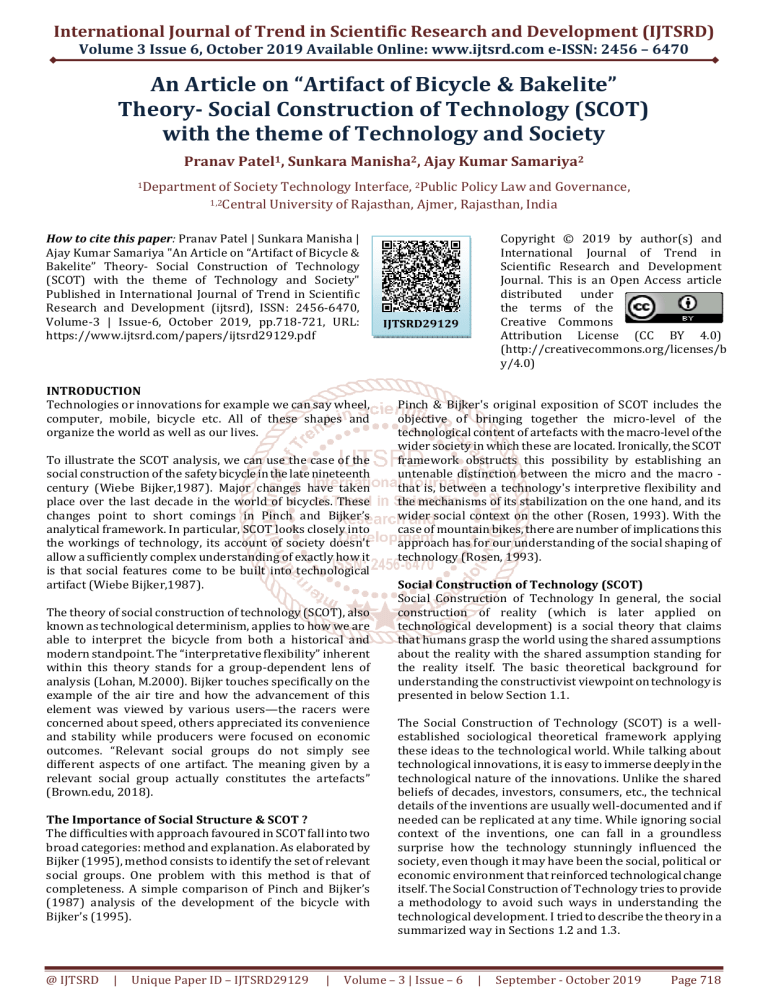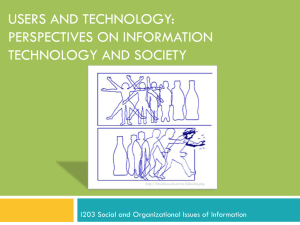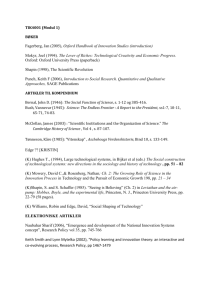
International Journal of Trend in Scientific Research and Development (IJTSRD)
Volume 3 Issue 6, October 2019 Available Online: www.ijtsrd.com e-ISSN: 2456 – 6470
An Article on “Artifact of Bicycle & Bakelite”
Theory- Social Construction of Technology (SCOT)
with the theme of Technology and Society
Pranav Patel1, Sunkara Manisha2, Ajay Kumar Samariya2
1Department
of Society Technology Interface, 2Public Policy Law and Governance,
1,2Central University of Rajasthan, Ajmer, Rajasthan, India
How to cite this paper: Pranav Patel | Sunkara Manisha |
Ajay Kumar Samariya "An Article on “Artifact of Bicycle &
Bakelite” Theory- Social Construction of Technology
(SCOT) with the theme of Technology and Society"
Published in International Journal of Trend in Scientific
Research and Development (ijtsrd), ISSN: 2456-6470,
Volume-3 | Issue-6, October 2019, pp.718-721, URL:
https://www.ijtsrd.com/papers/ijtsrd29129.pdf
INTRODUCTION
Technologies or innovations for example we can say wheel,
computer, mobile, bicycle etc. All of these shapes and
organize the world as well as our lives.
To illustrate the SCOT analysis, we can use the case of the
social construction of the safety bicycle in the late nineteenth
century (Wiebe Bijker,1987). Major changes have taken
place over the last decade in the world of bicycles. These
changes point to short comings in Pinch and Bijker’s
analytical framework. In particular, SCOT looks closely into
the workings of technology, its account of society doesn't
allow a sufficiently complex understanding of exactly how it
is that social features come to be built into technological
artifact (Wiebe Bijker,1987).
The theory of social construction of technology (SCOT), also
known as technological determinism, applies to how we are
able to interpret the bicycle from both a historical and
modern standpoint. The “interpretative flexibility” inherent
within this theory stands for a group-dependent lens of
analysis (Lohan, M.2000). Bijker touches specifically on the
example of the air tire and how the advancement of this
element was viewed by various users—the racers were
concerned about speed, others appreciated its convenience
and stability while producers were focused on economic
outcomes. “Relevant social groups do not simply see
different aspects of one artifact. The meaning given by a
relevant social group actually constitutes the artefacts”
(Brown.edu, 2018).
The Importance of Social Structure & SCOT ?
The difficulties with approach favoured in SCOT fall into two
broad categories: method and explanation. As elaborated by
Bijker (1995), method consists to identify the set of relevant
social groups. One problem with this method is that of
completeness. A simple comparison of Pinch and Bijker’s
(1987) analysis of the development of the bicycle with
Bijker’s (1995).
@ IJTSRD
|
Unique Paper ID – IJTSRD29129
|
Copyright © 2019 by author(s) and
International Journal of Trend in
Scientific Research and Development
Journal. This is an Open Access article
distributed under
the terms of the
Creative Commons
Attribution License (CC BY 4.0)
(http://creativecommons.org/licenses/b
y/4.0)
IJTSRD29129
Pinch & Bijker's original exposition of SCOT includes the
objective of bringing together the micro-level of the
technological content of artefacts with the macro-level of the
wider society in which these are located. Ironically, the SCOT
framework obstructs this possibility by establishing an
untenable distinction between the micro and the macro that is, between a technology's interpretive flexibility and
the mechanisms of its stabilization on the one hand, and its
wider social context on the other (Rosen, 1993). With the
case of mountain bikes, there are number of implications this
approach has for our understanding of the social shaping of
technology (Rosen, 1993).
Social Construction of Technology (SCOT)
Social Construction of Technology In general, the social
construction of reality (which is later applied on
technological development) is a social theory that claims
that humans grasp the world using the shared assumptions
about the reality with the shared assumption standing for
the reality itself. The basic theoretical background for
understanding the constructivist viewpoint on technology is
presented in below Section 1.1.
The Social Construction of Technology (SCOT) is a wellestablished sociological theoretical framework applying
these ideas to the technological world. While talking about
technological innovations, it is easy to immerse deeply in the
technological nature of the innovations. Unlike the shared
beliefs of decades, investors, consumers, etc., the technical
details of the inventions are usually well-documented and if
needed can be replicated at any time. While ignoring social
context of the inventions, one can fall in a groundless
surprise how the technology stunningly influenced the
society, even though it may have been the social, political or
economic environment that reinforced technological change
itself. The Social Construction of Technology tries to provide
a methodology to avoid such ways in understanding the
technological development. I tried to describe the theory in a
summarized way in Sections 1.2 and 1.3.
Volume – 3 | Issue – 6
|
September - October 2019
Page 718
International Journal of Trend in Scientific Research and Development (IJTSRD) @ www.ijtsrd.com eISSN: 2456-6470
Theoretical Background on Social Construction of
Reality
The social construction of reality is sociological theory that
was introduced by a book of the same name by Berger and
Luckmann (1966). The main question the theory attempts to
answer is: how do people attribute meaning in their
everyday life? In the reality of everyday life, people take
most of the concepts, events. Their meaning is not
considered problematic at all. Practical use of everyday
terms does not need to consider edge cases, does need to
resolve inconsistencies if they do not collide with the
practical use. This meaning can transcendent to the reality of
theoretical thinking only with the difficulties. Science often
deals with this problem by postulating theoretical concepts
which stand outside of everyday reality (e.g., mathematical
concept of set), another way can be seen often in philosophy
which problematize the everyday concepts beyond their
everyday use. When sociology wants to study social
phenomena of everyday reality, it needs to conduct
theoretical thinking over concepts of everyday reality which
are not suitable for this purpose. For example, the notion of
freedom as vaguely understood by most of the society
members will be certainly different from a rigorous result of
a thorough philosophical reflection of the notion of freedom
(Rust, 2006). The theory of social construction reality
overcomes this strange dichotomy meaning by
institutionalization of social phenomena, how they are
known and how this knowledge is passed in the society.
These can be rigorously described and thus provide a solid
foundation for further theoretical work. Objects in everyday
reality have a meaning for us when they declare subjective
intentions. For instance, a weapon always expresses a
general intent to commit violence and does it in an
intersubjective way- for everyone who knows how a weapon
look like and what it can be used for. This is possible due to
types of its use. On top of objects which express subjective
intentions directly, there are special objects which are called
symbolic signs (Libovicky, 2016). A sign is something that
carries subjective intention, which is typical but independent
on immediate situation (it is possible to threat someone
without showing an actual weapon, by just using words).
Most of human activity usually get habituated, for example
repeated activities eventually become patterns. The evident
practical psychological advantage of habituation is that we
do not need to re-invent everything when we do it and
gradually get better in the activities. Mutual type of
habituated activities is called institutionalization. Social
institutions emerge during the shared history, set normative
patterns of human behaviour and apply social control on it. It
can be illustrated on a simple example of a Parents and their
children. When a childless couple decides they will organize
their everyday life in a particular way, their decisions are
already a potential social institution. They know that they
agreed on that and that they can change it any time (Rust,
2006). The same process happens in much larger scale in the
whole society. Keeping together a society with many diverse
groups living in different every day realities requires a value
framework in which existence of the other groups is
legitimate. In below section we can see constructivist
viewpoint on technology.
whereas his opinions on physics or biology seem to be naive
or even stupid. These thoughts led him to inventing a notion
of scientific paradigm and introducing his theory of scientific
revolutions. Maybe these were similar thoughts that led
Wiebe Bijker to develop his theory of social construction of
technology. Having lived in the Netherlands, he must have
been surrounded by bicycles and thought how was it
possible that even though the technological means necessary
for constructing a modern bicycle were available for merely
half a century, it took until the beginning of the 20th century
before the modern bike became a device usable as a means
of everyday transportation (Bijker, 1997). In a book Of
Bicycles, Bakelites, and Bulbs (Bijker, 1997), it became a
prototypical case of how social, political and economic
aspects influence the technology as much as the technical
aspects. The Social Construction of Technology is a
conceptual framework that started its development in the
late 1970s as a critical reaction on so called technological
determinism (Bijker, 1997). Technological determinism
assumes that technology develops autonomously, having its
own internal logic and it is therefore the technology
influences to a great extend the social development. A
famous example of this approach is work of Marshall
McLuhan, who was able to explain in this manner many
important moments of history of human communication and
demonstrate how the technological innovation in human
communication had fundamentally changed the way the
western world worked (McLuhan, 1964). The limitations of
the deterministic view arise clearly when we start to ask
questions like: was the Space Shuttle Challenger disaster in
1986 primarily a technical failure, an organizational mistake
or a lack of funding (Bijker, 2010; Vaughan, 1997)? At the
first sight, it may seem it was indeed a technological failure
because it was the technology what failed. When this is
analysed more thoroughly, it becomes obvious that none of
the suggested reasons is the primary one and that all the
mentioned factors form a ‘seamless web’ (Bijker, 1997) of
mutually interconnected relevant aspects. Along with
underestimating the role of political and economic
environment, there is another political risk that can follow
from technological determinism. The assumption that world
of technology is constituted by expert knowledge of the
technologists, firmly rooted in the objective world and
therefore can be a source of “objective” policy-making advice
(Bijker, 2006), disregarding any implicit ideology driving the
technological development. SCOT applies the constructivist
twist in sociology of technology. If we silently assume
contemporary meaning and values attributed to technology
together with universally valid objective engineering
conceptualization of the technology development, the fact
people did not invent a modern bicycle fifty years earlier is
indeed understandable. In order to find out why that
happened, we should focus less on the technological side of
the problem and take into account values that were
attributed to the technology during its development
(Libovicky, 2016). However, from the theory of social
construction of reality, we already know they can be
captured by the process of institutionalization of the
technology use and other social phenomena associated with
the technology.
Constructivist Viewpoint on Technology
Thomas Kuhn starts his Structure of Scientific Revolutions
(Kuhn, 1970) by the following thought: how it is possible
that so many Aristotle’s ideas are still valid nowadays,
Conceptual Framework of SCOT
From what was just said, it appears that term technology in
the conceptual framework of SCOT includes not only the
technology artefacts and technological systems themselves,
@ IJTSRD
|
Unique Paper ID – IJTSRD29129
|
Volume – 3 | Issue – 6
|
September - October 2019
Page 719
International Journal of Trend in Scientific Research and Development (IJTSRD) @ www.ijtsrd.com eISSN: 2456-6470
but also the knowledge about them and the practices
connected with them. The theory distinguishes four levels of
analysis: a singular artifact, a technological system, a
socioecological ensemble and technological culture. By
trying to come up with a formal definition of these concepts
(as in case of any other concepts), I would end up with
complicated definitions with a long discussion on edge cases.
For simplicity, I only illustrate the levels by describing
typical phenomena that belong to the particular levels of
analysis. A singular artifact is a technological product, no
matter whether a product invention (e.g., bicycle, smart
phone) or a process invention (e.g., Bakelite, deep learning).
The subject of study is a story of how a singular machine or a
process is socially shaped. The key concepts the SCOT works
with are the ‘relevant social groups’ and ‘interpretative
flexibility’. A relevant social group is any social group that
attributes a meaning to the technology. Although, a
membership in the groups can massively overlap, every
relevant social group in fact sees actually a different artifact
than the others. If we follow the example provided by Bijker
(1997), for the high-wheeled bicycle that was common in the
1870s there were at least four relevant social groups:
1. bicycle producers who wanted to make profit on the
bicycle production,
2. young athletic men who wanted to show off themselves,
3. women bikers who faced gender discrimination because
they could not wear proper clothes while riding a
bicycle, and
4. conservative moralist who has seen bicycles as an
eccentric and dangerous thing.
The existence of parallel interpretations is called
‘interpretative flexibility’. The later phases of the artifact
development when it reaches a stable design are called
‘stabilization’ and ‘closure’. At these phases, the artifact
development can be narrated as a linear path of consecutive,
mutually undermined inventions leading to the artefact
(Bijker,1997). Bijker (1997, p. 271) claims that after the
closure, the history gets immediately rewritten. In the case
of bicycles, this was reached by introducing the so called
‘safety bicycle’ whose design is stable since a century ago.
This builds up a ‘technological frame.’ These terms can be
seen as analogical Kuhn’s conceptualization of scientific
development. The ‘technological frame’ corresponds to
Kuhn’s ‘normal science’ and ‘closure’ to the moment when an
‘alternative paradigm’ becomes the dominant one (Bijker,
1997).
Stabilization of the technological frame can be illustrated
also on more recent examples. Few years ago, there were
competing concept of touch screen smart phone and
Blackberry smart phones with a physical QWERTY keyboard.
Although at some point, the Blackberry phones were very
popular. In the UK, they were so popular that they were
attributed a crucial role in the 2011 London riots (Halliday,
2011). Having one these days would seem ridiculous. The
concept of ‘technological system’ goes beyond the artifact
and except the technical elements, it comprises the social,
organizational, economic and political issues as well. When a
technology grows, more a more capital, more technology and
business effort are invested in its development—this builds
up ‘technological momentum’ which is the most important
phenomenon on the system level. The bigger the momentum
is, the harder is changing the course of the development. A
@ IJTSRD
|
Unique Paper ID – IJTSRD29129
|
good example of an unstoppable momentum is why we still
use QWERTY keyboards despite the original technological
motivation for this layout is no longer valid (Bijker, 2006, p.
29).
A ‘sociotechnical ensemble’ is a similar concept to a
‘technological system’, again considering a broader social
context.
History of the bicycle
The history of the bicycle is so fraught with unknowns and
confusion that a yearly Bicycle History conference is held in
attempt to clarify these details. Currently in its 15th year, I
think some progress has been made.
1818- the dandy horse or “running machine” invented by
Karl von Drais This contraption was propelled by the rider
pushing himself along with this foot on the ground. Lacking
pedals, a steering mechanism and brakes, it was difficult and
even dangerous to manoeuvre.
1850- First three-wheeler, allowing for a more stable ride.
1860- First true bicycle invented by Ernest Michaux and
Pierre
Lallement,
known
as
the
velocipede
1861- Included crank and pedals but not yet brakes,
resulting in many dangerous “headers”
1870- Penny Farthing bicycle invented. The name came from
the idea that the wheels resembled two coins, the penny and
the farthing next to each other, the former significantly
larger than the latter. It was unstable, extremely difficult to
get on and off and the front wheel was used for power and
steering. Considering, it was not an ideal or efficient
machine.
1885- safety bicycle invented by John Kemp Starley
characterized by two wheels of the same size and a rear
wheel connected and driven by a chain. This made for a
more efficient bicycle that could use smaller wheels. This
invention was named for the obvious reason that it was safer
than the penny-farthing because of the lower centre of
gravity.
1894- Betty Bloomers became popular. Women were no
longer limited to tricycles and could ride comfortably in their
long skirts
1903- Internal hub gears invented 1920- The Kids Bike
invented. This design, weighing in at around 65 pounds,
mimicked aspects of the motor vehicle as the automobile
became more desirable than bikes.1930- Schwinn adds
spring fork and fat tire to handle the abuse of teenage boys.
This later became the preliminary design for the mountain
bike.
2000- Electric bike. History of bicycle data is taken from
URL:https://www.brown.edu/Departments/Joukowsky_Inst
itute/courses/13things/7083.html
References
[1] https://www.brown.edu/Departments/Joukowsky_Ins
titute/courses/13things/7539.html
[2] https://www.brown.edu/Departments/Joukowsky_Ins
titute/courses/13things/7083.html
Volume – 3 | Issue – 6
|
September - October 2019
Page 720
International Journal of Trend in Scientific Research and Development (IJTSRD) @ www.ijtsrd.com eISSN: 2456-6470
[3] Wiebe Bijker, 'The Social Construction of Bakelite:
Towards a Theory of Invention', in Bijker, Thomas P.
Hughes and Trevor Pinch (eds), The Social
Construction of Technological Systems: New Directions
in the Sociology and History of Technology (Cambridge,
MA: MIT Press, 1987)
[4] Rosen, P. (1993). The Social Construction of Mountain
Bikes: Technology and Postmodernity in the Cycle
Industry. Social Studies of Science, 23(3), 479-513.
Retrieved from http://www.jstor.org/stable/370257
[9] McLuhan, M. (1964). Understanding media: the
extensions of man. McGraw-Hill.
[10] Bijker, W. E. (2010). How is technology made?–That is
the question! Cambridge Journal of Economics, 34(1),
63-76.
[11] LIBOVICKÝ, J. Deep Learning as a Socially Constructed
Technology Master’s thesis,
[12] Charles University: Prague, 2016. Faculty of Social
Sciences.
[5] Brown.edu. (2018). The Bicycle as an Artifact of Social
[13] Halliday, J. (2011). London riots: How blackberry
Construction.
[online]
Available
at:
messenger played a key role (Vol. 8). London, United
https://www.brown.edu/Departments/Joukowsky_Ins
Kingdom: Guardian News and Media Limited.
titute/courses/13things/7539.html [Accessed 5 Dec.
(Accessed: 29/7/2016)
2018].
[14] Bijker, W. E. (2006). Why and how technology matters.
[6] Lohan, M. (2000). Constructive Tensions in Feminist
In R. E. Goodin & C. Tilly (Eds.), Oxford handbook of
Technology Studies. Social Studies of Science, 30(6),
contextual political analysis (pp. 681–706). Oxford,
895-916.
Retrieved
from
United Kingdom: Oxford University Press.
http://www.jstor.org/stable/285790
[15] Rust, J. (2006). John Searle and the construction of social
[7] Bijker, W. E. (1997). Of bicycles, bakelites, and bulbs:
reality. London: Continuum.
Toward a theory of sociotechnical change. MIT Press
[16] Rosen, P. (1993). The Social Construction of Mountain
[8] Berger, P., & Luckmann, T. (1966). The social
Bikes: Technology and Postmodernity in the Cycle
construction of reality: A treatise in the sociology of
Industry. Social Studies of Science, 23(3), 479-513.
knowledge. Doubleday.
Retrieved from http://www.jstor.org/stable/370257
@ IJTSRD
|
Unique Paper ID – IJTSRD29129
|
Volume – 3 | Issue – 6
|
September - October 2019
Page 721





